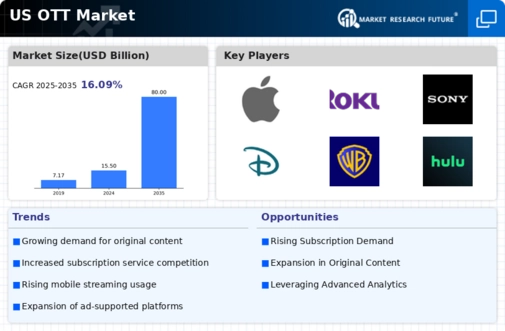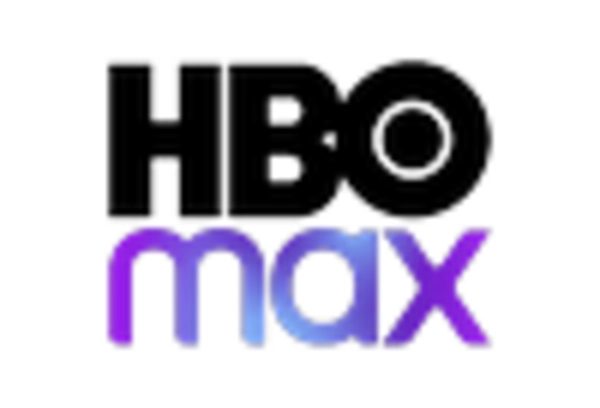The OTT market in the US is characterized by intense competition and rapid evolution, driven by technological advancements and shifting consumer preferences. Major players such as Netflix (US), Amazon Prime Video (US), and Disney+ (US) are at the forefront, each adopting distinct strategies to maintain and enhance their market positions. Netflix (US) continues to focus on original content production, investing heavily in diverse programming to attract a broad audience. Meanwhile, Amazon Prime Video (US) leverages its extensive e-commerce ecosystem to bundle services, enhancing customer loyalty through value-added offerings. Disney+ (US), with its rich library of beloved franchises, emphasizes family-oriented content, positioning itself as a leader in the family entertainment segment. Collectively, these strategies contribute to a competitive landscape that is both dynamic and multifaceted.
In terms of business tactics, companies are increasingly localizing content to cater to regional tastes, optimizing their supply chains to ensure timely delivery of services. The competitive structure of the OTT market appears moderately fragmented, with several key players vying for market share. This fragmentation allows for innovation and niche offerings, as smaller players can carve out specific segments while larger companies dominate the mainstream market.
In October 2025, Netflix (US) announced a partnership with a leading gaming company to develop interactive content, which could potentially redefine viewer engagement. This strategic move not only diversifies Netflix's content offerings but also taps into the growing intersection of gaming and streaming, appealing to a younger demographic that seeks immersive experiences. The implications of this partnership may extend beyond content, influencing how audiences interact with media.
In September 2025, Amazon Prime Video (US) launched a new initiative aimed at enhancing its user interface through AI-driven recommendations. This development is significant as it reflects a broader trend towards personalization in content delivery, potentially increasing viewer retention and satisfaction. By utilizing advanced algorithms, Amazon Prime Video (US) aims to create a more tailored viewing experience, which could lead to higher subscription rates and reduced churn.
In August 2025, Disney+ (US) expanded its content library by acquiring rights to several international films, thereby enhancing its global appeal. This strategic acquisition is indicative of Disney+'s commitment to becoming a comprehensive entertainment platform, catering to diverse audiences. By broadening its content offerings, Disney+ (US) positions itself to compete more effectively against rivals, particularly in markets where local content is paramount.
As of November 2025, the OTT market is witnessing trends such as increased digitalization, sustainability initiatives, and the integration of AI technologies. Strategic alliances are becoming more prevalent, as companies recognize the value of collaboration in enhancing their competitive edge. Looking ahead, it appears that competitive differentiation will increasingly hinge on innovation and technological advancements rather than solely on pricing strategies. The focus is shifting towards creating unique, engaging content and ensuring reliable service delivery, which may redefine the parameters of competition in the OTT landscape.

















Leave a Comment